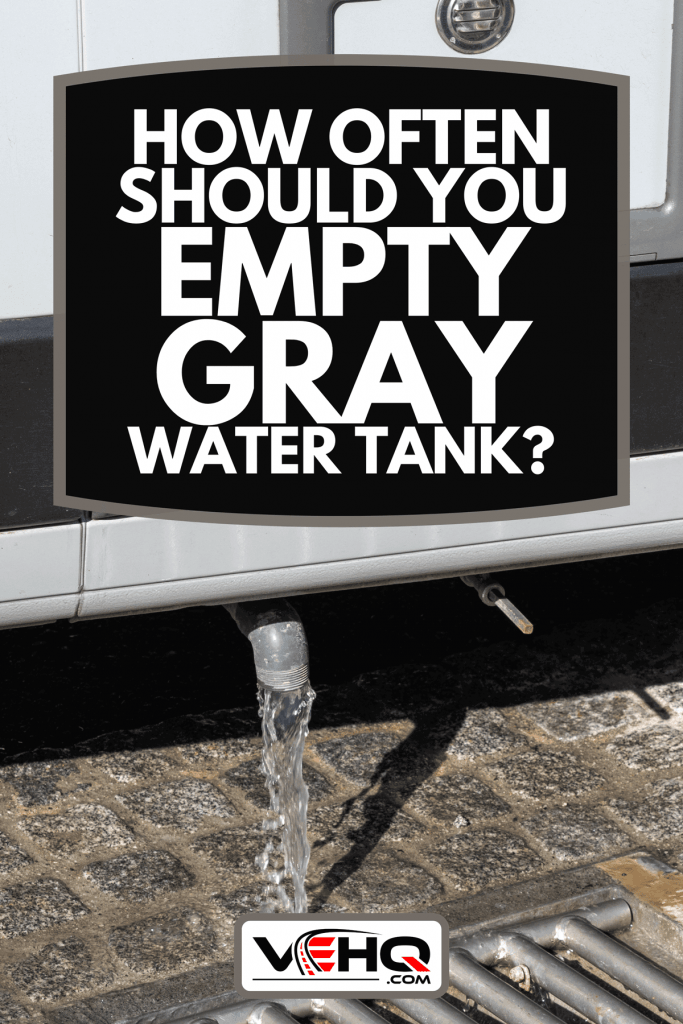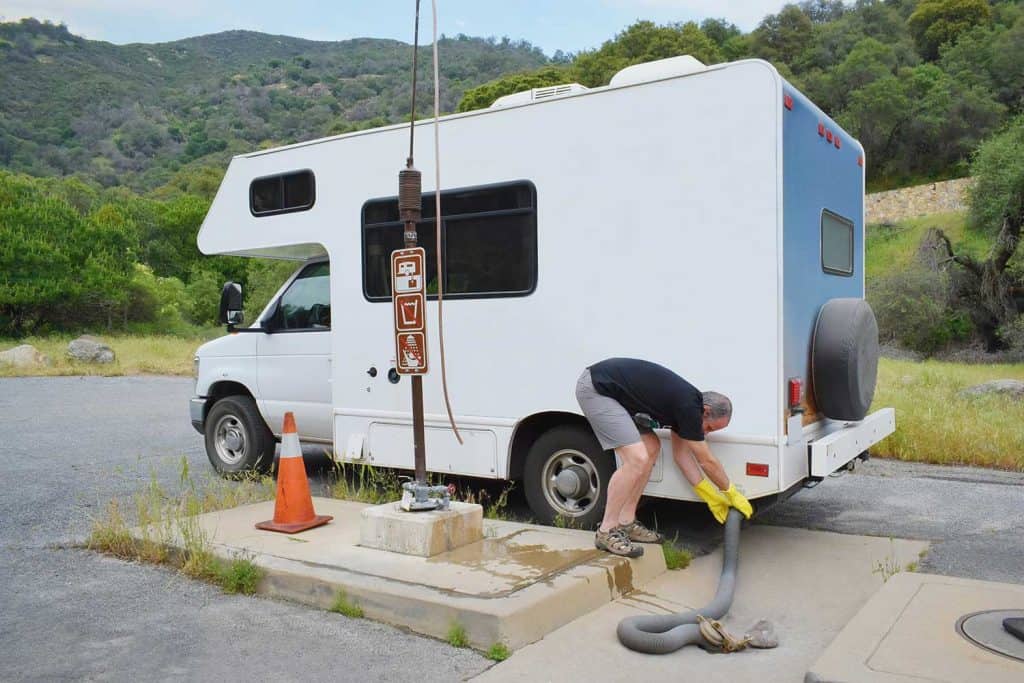If you're an RVer, your freedom to hit the road and camp for weeks at a time is bounded only by the size of your gray water tank. Although it may sound like a joke, there is actually substantial truth to this statement. Your gray water tank fills up quickly with wastewater from the shower, kitchen, and bathroom sink, and if it overflows, it can cause major damage to your RV. So, how often should you empty the gray water tank? We've done the research, and we have the answers for you!
You should empty your RV's gray water tank when it is 2/3 full or more. If you're traveling alone or with one other person, you might empty the tank every five to seven days. On the other hand, if there are several people in your group, you may need to empty your RV's gray water tank every one or two days.
In the remainder of this article, we'll explain how often to empty the gray water tank and how to do it. We'll also tell you how to tell the gray water valve from the black water valve, how to know when the gray water tank is full, and what happens if your gray water tank overflows. And we'll address the age-old RVer question: is it okay to dump gray water on the ground? Keep reading to learn everything you need to know about your gray water tank!

How Often Should You Empty Gray Water Tank?
Wait until your RV's gray water tank is at least 2/3 full before you empty it. To fully understand the best practices for emptying your gray water tank, it's helpful to know how it functions within your RV's entire water and waste system.
RV Gray Water Basics
Your RV's water system consists of three tanks, each with intake and outflow valves and the plumbing that connects them.
Freshwater
The freshwater tank holds unused, potable water. You can fill it from any freshwater source, typically your home's garden hose or the potable water hose at an RV station. It dispenses water to your RV's toilet, sinks, and shower.
Gray Water
Runoff from the sinks and shower goes into the gray water tank. This water contains bacteria and bits of solid waste, but it is not as toxic as the runoff from the RV's toilet.
Black Water
Water and waste from your RV's toilet flow into the black water tank. The contents of the black water tank are toxic and must be disposed of according to strict rules.
The contents of the gray and black water tanks can become smelly if the tanks are not emptied regularly.
Click here for RV fresh and gray water tanks on Amazon.
Best Practices In Emptying Gray Water Tank

Always empty the black water tank before the gray water. The less-toxic gray water will flush away any solid residue left in the drain hose after you empty the black tank.
Wait until the gray water tank is at least 2/3 full before emptying it. The extra mass increases the rate of flow out of the tank and through the drain hose, helping to flush solid matter out of the system.
Don't leave the gray water tank valve open continuously. Gray water contains small bits of solid waste, mostly from your kitchen sink. This waste can become trapped in the bottom of the tank if you drain the water too frequently.
Always empty your gray water tank in designated city sewer systems, RV station drains, or your septic system. Never dump it on the ground or into a body of water.
How To Empty Your Gray Water Tank
- Remove the cap covering the outflow valve for the gray and black tanks.
- Connect your sewer hose to the outflow valve. Some RVs have one outflow valve for the gray and black tanks; others have separate valves.
- Run the hose from your RV to the sewer's dump hole. Ideally, use a sewer hose support system to eliminate dips, humps, or kinks.
- Place the other end of the hose in the dump hole. Make sure the end is at least 5" into the hole.
- Use the dump hole's cover to hold the sewer hose in place.
- Open the black tank valve and allow the black water to flow out until the tank is empty.
- Close the black tank's outflow valve.
- If your RV has separate outflow valves for the gray and black tanks, disconnect your hose from the black tank and connect it to the gray tank.
- Open the gray tank's outflow valve and allow the gray water to flow out until the tank is empty.
- Close the gray tank's outflow valve.
- Unhook the sewer hose from the RV's outflow valve.
- Holding the end of the sewer hose up, walk your way to the sewer, making sure that all the fluid drains from the hose into the sewer.
- Run fresh water through the sewer hose to flush it.
- Remove the end of your sewer hose from the drain.
- Rinse the outside of your hose and the area surrounding the drain.
- Replace the cover on the sewer drain.
- Store your sewer hose.
- Add RV water treatment to your black and gray water tanks.
If possible, flush your black and gray water tanks by following these steps prior to unhooking the swear hose (step 11), after the gray water has been emptied:
- Fill the fresh water tank.
- Run the water in your sink and flush the toilet numerous times.
- Open the black tank valve and allow all the water to flow out of the black tank.
- Close the black tank valve.
- Open the gray tank valve and allow all the water to flow out of the gray tank.
- Close the gray tank valve.
Click here for sewer hose support system on Amazon.
Which Valve Is Gray Water On A Camper?
Most RVs come with decals marking the valves for the gray and black water tanks. However, sometimes these decals wear off. You can still determine which valve belongs to which tank, although this task isn't a lot of fun.
Locate the outflow valve(s) for the gray and black water tanks. Crawl under your RV and examine the pipes that run to the valve. The black tank's sewage pipe is larger, 3" or more in diameter, to allow solid wastes from the toilet to pass through. The drain pipe for the gray tank is smaller -- usually about 2" in diameter.
To avoid having to repeat this process, mark each valve handle with gray or black electrician's tape.
Click here for black electrician's tape on Amazon.
How Do I Know When The Gray Tank Is Full?
Ideally, your tank's sensor monitor will show you when your gray tank fills up. However, the sensors can malfunction if they become covered with paper, grease, or other solid waste. This can cause your monitor to show the tank as full when it is not, or worse, to tell you that your tank is only partly full when, in fact, it is about to overflow.
Double-check the sensors every time you empty your gray water tank by checking the readout on your monitor -- it should show that the tank is empty. You can also clean the sensors by adding enzymatic sensor cleaner to your gray tank.
If you don't have sensors, or if they malfunction, you will know that your gray water tank is full when your shower, kitchen sink, or bathroom sink will no longer drain. This is a sure sign that the tank is full, and you need to empty it immediately.
Click here for RV tank monitor replacement kit on Amazon.
What Happens When The Gray Water Tank Is Full?
When your gray water tank is full, excess water backs up through the floor drain and into your shower pan. If you notice the backup and empty the tank before the shower pan overflows, no problem.
But, if you are unaware of the backup, your shower pan will overflow, spilling gray water onto the bathroom floor. This can ruin your carpet and flooring, as well as your bathroom cabinets and any insulation in the walls and floor. If the overflow reaches beyond the bathroom to other parts of your RV, it can cause extensive damage.
Remember that gray water, although it doesn't contain feces and urine like black water, still has contaminants in it. A backup can result in lingering odors and mildew.
Click here for tank sensor cleaner on Amazon.
Is It Okay To Dump Gray Water On The Ground?
Gray water contains food particles, grease, hair, soap, and chemical contaminants. Although it's not nearly as toxic as black water, you still should not dump gray water on the ground or into bodies of water.
Each state in the US has its own laws about the disposal of gray water, and federal lands also have differing regulations. Make sure you know the rules wherever you camp.
Should I Leave My RV Gray Tank Open?
Some RVers advocate leaving their gray water tank's outflow valve open while camping to prevent the tank from filling and overflowing. There are two reasons not to do this:
- If you leave the valve open, all of your gray water with its chemicals, bacteria, and other contaminants, will flow out onto the ground instead of into a sewer.
- Leaving the valve open will drain the gray water tank, leaving nothing to help flush out the sewer hose after you empty the black water tank.
In Closing
Now that you know when and how to empty your RV's gray water tank, you can hit the road without fear of an overflow ruining your vacation and causing permanent damage to your RV. Enjoy the trip!
You may also enjoy these articles:





